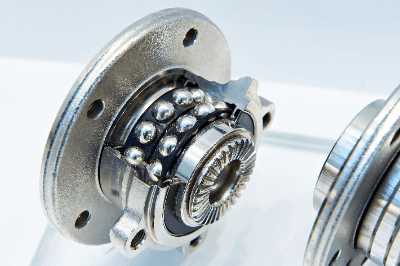What Is an Angular Contact Bearing?
 An Angular Contact Bearing is a bearing that can support loads parallel to the axis (axial load) and loads perpendicular to the axis in one direction (radial load) simultaneously.
An Angular Contact Bearing is a bearing that can support loads parallel to the axis (axial load) and loads perpendicular to the axis in one direction (radial load) simultaneously.
It is similar to deep groove bearings, but there is a difference. The grooves on the outer ring of a deep groove bearing are symmetrical in the axial direction, while the grooves on the outer ring of an angular contact bearing are slanted at a certain angle. This allows them to support both axial and radial loads.
Angular contact bearings are used to support shafts of pumps, various compressors, press machines, elevator hoisting machines, etc.
Uses of Angular Contact Bearing
Angular contact bearings are used in sets of several pieces. In this case, they are designed to support axial loads in a single direction or in both directions by changing the way they are combined.
1. Single Row Type
Two bearings are used in a single row, facing each other, with adjustable internal clearance. Capable of supporting radial loads and axial loads in one direction. Suitable for applications such as machine tool spindles, where rigidity and rotational accuracy of bearings are required.
They are also used in pumps, various compressors, screw chillers, elevator hoisting equipment, etc.
2. Double-Row Type
This is a structure in which a pair of angular contact bearings are installed in a single bearing as a back-to-back combination. It can support axial loads in both directions. Since it can also support moment loads, it is used as a fixed side bearing. Used in compressors, presses, automatic guided vehicles, belt conveyors, etc.
3.Combination Type
Multiple single-row type bearings are combined. There are three types of combination types: front combination, back combination, and parallel combination. If the axial load is in a single direction, large loads can be supported. Applications include pumps, compressors, screw chillers, and elevator hoisting equipment.
Principle of Angular Contact Bearing
Angular contact bearings can support both radial and axial loads by having a contact angle. The contact angle is the angle between the direction perpendicular to the axis and the direction of the load applied between the raceways and rolling elements when both radial and axial loads are applied to the bearing.
The larger the contact angle, the greater the capacity to take axial loads, and the smaller the contact angle, the wider the operating range up to higher speeds.
Since a radial load causes a bifurcation force on the axial load, the axial load, several bearings are used together to accommodate the bifurcation force.
Other Information on Angular Contact Bearing
1. Angular Contact Bearing Orientation and Assembly
Angular contact bearings are used in multiples because of their contact angle. There are several types of assembly methods, such as DB type with back contact angle, DF type with front contact angle, DT type with parallel contact angle, and other combinations of three or more bearings, each of which has its own characteristics.
The DB type is the most commonly used method of assembly, in which the back faces of the bearings are aligned with each other. It can handle radial loads and axial loads in both directions. It can support the largest moment loads of all combinations.
If the bearing is a pressurized type, the clearance can be adjusted simply by setting the inner ring with a nut. The DB type is superior in its ability to take moment loads.
The DT type can accommodate radial loads and axial loads in one direction by stacking the bearings in the same direction. Since axial loads are supported by two bearings, it is used when axial loads in one direction are large.
2. Pressurized
When two bearings are used opposite each other, as in the case of angular contact bearings, the axial clearance may be negative. This condition is called pressurizing and can accommodate larger moments.
This is especially true for the DB type (back-to-back assembly), because when two angular contact bearings are back-to-back assembled, the distance between the points of action becomes larger due to the contact angle between them, and thus the bearing can withstand more moments.
Preloading not only increases the moment capacity, but also enables adaptation to high speed rotation, improves the positioning accuracy and rotational precision of the bearing, and suppresses vibration and abnormal noise. Three preload levels are usually available: light, medium, and heavy preload.
Preload is set by grinding the ring end faces to create a step between the inner and outer rings. The preload can also be increased or decreased by stepping the width of the inner and outer ring spacers.